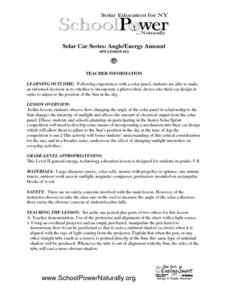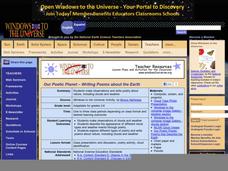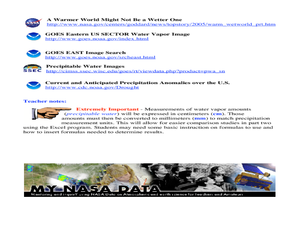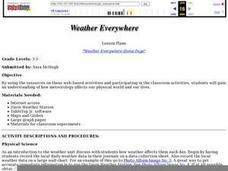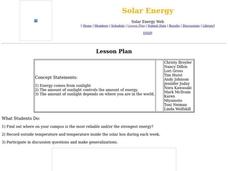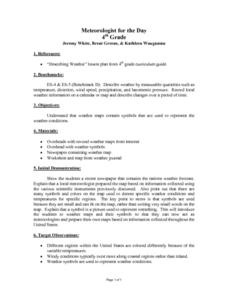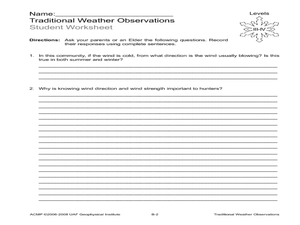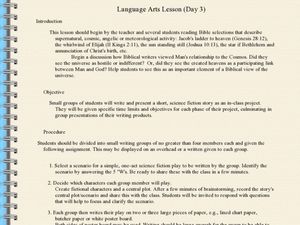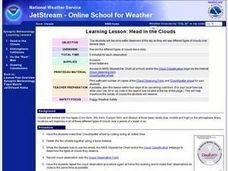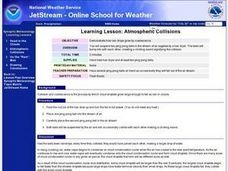Center Science Education
Weather in the News
Tornadoes, blizzards, and hurricanes, oh my! In this instructional activity, meteorology majors compare stories of historical storms written by two or more different sources. As a result, they understand how the media portrays such...
Curated OER
Solar Car Series: Angle/Energy Amount
Does the angle of a solar panel change the output? Emerging engineers find out! Demonstrate for your class how they can angle a straw to match the angle of light rays coming from a source. Then turn them loose to experiment with the...
Teach Engineering
Weather Forecasting
According to the Farmers' Almanac, the weather will be nice today. Class members examine how weather forecasting plays a part in their lives with a resource that provides information on the history of forecasting, from using cloud...
Curated OER
Our Poetic Planet - Writing Poems about the Earth
As a way to combine language arts and science, try this lesson on writing cloud poetry. Begin by showing a PowerPoint presentation and images of cloud types. Take meteorology masters outdoors to explore the sky using the provided "Cloud...
Curated OER
Create a Cloud in a Bottle
Meteorology or earth science classes reach for the sky with this lesson plan! You will need to purchase a Fizz Keeper® device and temperature strip for each lab group if you want them to perform this as an activity rather than you doing...
Curated OER
A Comparison Study of Water Vapor Data to Precipitation over North America
Students use NASA satellite data to compare water vapor over the United States. In this data analysis instructional activity students use an Excel spreadsheet to map their data.
Curated OER
Weather Everywhere
Students gain an understanding of how meteorology affects our physical world and our lives. They utilize resources on web-based activities and participate in the classroom activities to enrich their understanding.
Curated OER
How Clouds And Fog Are Formed
Students define what a cloud is and what fog is. After a lecture/demo, students participate in an experiment on how clouds and fog are formed. In pairs, they perform the experiment a second time, record their results and present to the...
Curated OER
Solar Energy
Students find out where on campus is the most reliable and/or the strongest energy, record outside temperature and temperature inside the solar box during each week, and participate in discussion questions and make generalizations.
Curated OER
Meteorologist for the Day
Fourth graders examine the symbols used on weather maps. They analyze a newspaper weather forecast and identify and discuss the various symbols used on the map. Next, they prepare a weather map for their own city using the symbols...
Curated OER
Weather Report Chart
Students complete a weather report chart after studying weather patterns for a period of time. In this weather report lesson, students measure temperature, precipitation, cloud cover, wind speed, and wind direction for a month. Students...
Curated OER
Traditional Weather Observations
Students explore traditional methods of weather observation. In this weather lesson, students interview grown-ups regarding wind. Students learn how winds can help forecast weather.
Curated OER
Weather or Not
Sixth graders explore weather. In this meteorology lesson, 6th graders create weather instruments and compare and contrast weather data.
Curated OER
Weather Wonderings
Students explore the various types of weather. They discuss the difference between tornado watches and tornado warnings. Students investigate the various types of clouds. They sketch and label the 8 different types of clouds. Students...
Curated OER
Meteorology
Second graders identify and describe the three types of clouds. They discover the type of weather associated with each cloud type as well. They ask questions to complete the lesson.
Curated OER
Meteorology -- Clouds
Fourth graders examine the processes of condensation and evaporation. They identify the three types of clouds and state the weather that is possible with each type of cloud. They ask questions to end the lesson.
Curated OER
Bible Readings: Supernatural, Cosmic, Angelic, Meteorological
Students create and present a short science fiction story. For this Bible studies lesson students work in small groups and are assigned characters and a scenario to develop a play about.
Curated OER
Aspects of Weather
Students recognize and observe weather phenomena. In this four part weather lesson, students are introduced to weather symbols through a story, then use a thermometer to measure water temperature. Next, students observe the formation of...
Curated OER
Learning Lesson: Head in the Clouds
Learners observe and describe the sky as they discover the different cloud types. They record the types of clouds they see twice a day. They also use the internet to view a skywatcher chart. They end the lesson by discussing foggy...
Curated OER
Learning Lesson: Atmospheric Collisions
Students participate in a demonstration showing how rain drops grow by coalescence. They use ping pong balls and put them in an air stream. They end the lesson discussing flash flood safety.
Curated OER
Learning Lesson: Measure the Pressure II -- The "Dry" Barometer
Students use simple items to create their own aneroid barometer. They have five days to build it and ten days to observe and collect data. They examine tornado safety tips to end the instructional activity.
Curated OER
Thunderstorm Outflow
Young scholars list at least three physical characteristics of a thunderstorm outflow. They explain what physical process occurs in a thunderstorm to create the storm's outflow, and locate the thunderstorm's outflow.
Curated OER
Meteorological Predictions
Pupils make a link between prediction and hypothesis in math and science. Based on data collected over one week, students evaluate the predictions of local weather forecasters, compare the predicted outcomes to the actual weather...
Curated OER
Believe It...Or Not
Students critically analyze data regarding climate changes using a glossary of terms generated by examination of climate related articles. They examine and graph climatic data, and discuss, hypothesize and test apparent discrepancies in...

